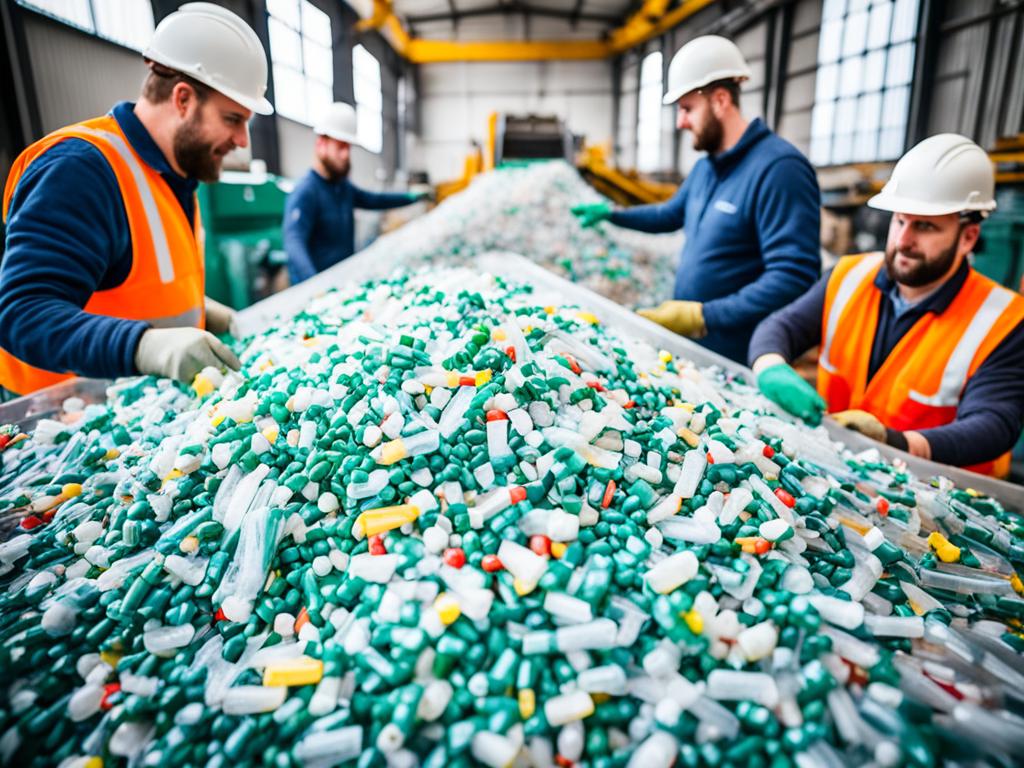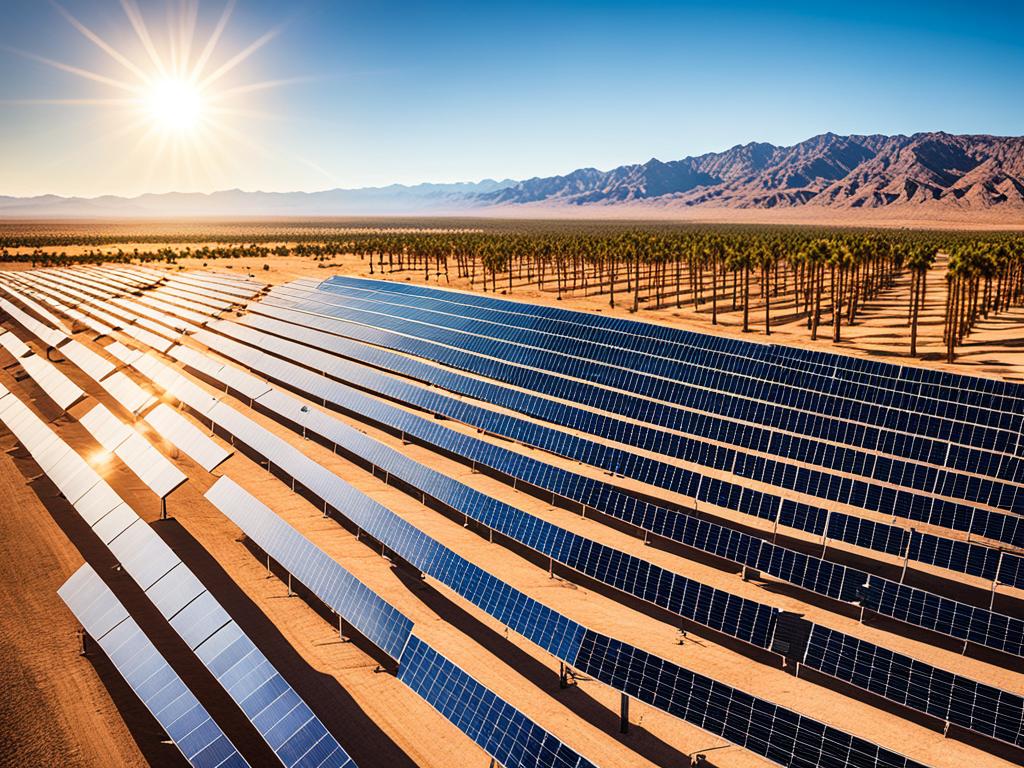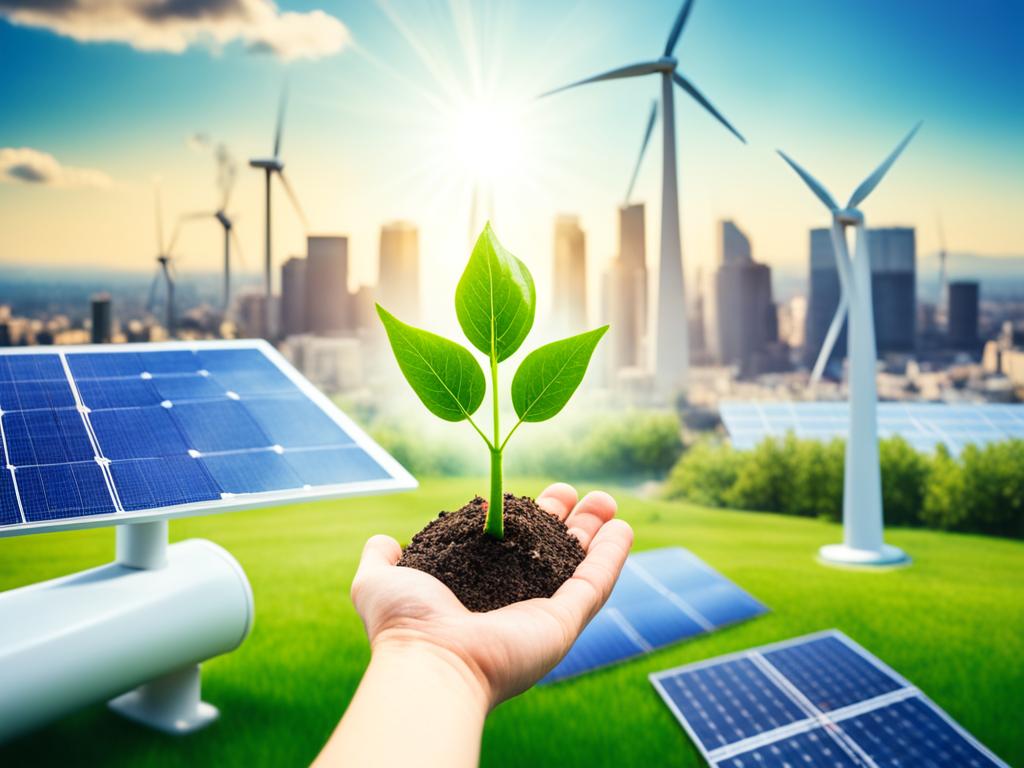Innovation is pushing us forward, aiming for a greener planet. Many companies are using sustainable innovation to fight climate change. They are creating eco-friendly possibilities. This includes electric vehicles, plastic recycling technologies, and green financial products. Also, solar power, carbon-capturing technologies, and LED lighting make a difference.
These innovations change industries and our daily lives. They focus on using renewable energy, green building materials, and waste reduction. As a result, they cut carbon emissions and provide clean electricity. They also capture carbon and lower environmental harm. This path leads us to a cleaner, brighter future.
Key Takeaways
- Eco-friendly technologies are driving innovation for a sustainable future
- Sustainable innovations are transforming industries and daily life
- Renewable energy solutions play a significant role in reducing carbon footprint
- Green technologies are providing tools for environmental solutions
- Investing in green technology can pave the way for a healthier future
Electric Vehicles: Driving Towards a Sustainable Future
The world of transportation is changing fast, moving from gas cars to electric. This switch is crucial for the environment. Every year, more people are buying electric, plug-in hybrid, and hybrid cars around the world. In 2021, over 6.6 million electric cars were purchased. As electric vehicle tech gets better, more people are choosing to drive cleaner cars.
Public Transportation
In many places, public transportation is going electric too. China leads with electric buses in its cities, offering eco-friendly rides. These buses make cities quieter and more enjoyable for everyone. Soon, European cities will follow this green trend.
Commercial Trucking
Big trucks are also going through a big change, switching to electric. By 2030, more trucks on the road will be electric than gas. This move is a big step in making shipping and transport cleaner. It will help the planet by cutting down harmful emissions.
Switching to electric vehicles is a major win for the environment. Every year, an electric car makes way less CO2 than a gas car. Governments are helping out with money-saving incentives and charging stations. This support makes it easier for everyone to join the electric car movement.
Electric cars are not just good for the planet; they’re also becoming more affordable. Every year, the quality of batteries gets better while prices drop. This makes it possible for more people to buy electric cars. The industry is also finding smart ways to recycle batteries, supporting a green future.
Moving all vehicles, from small cars to big trucks, to electric is key for our planet. Using electric vehicles helps save our environment by cutting down on pollution. It’s a big step to a cleaner and greener way of moving around.
Plastic Recycling: Transforming Waste into Resources
Plastic manufacturing and recycling processes are changing. They now use sustainable ways and green tech to lessen the harm on our planet. One key change is the use of plastic-eating bacteria. These bacteria eat non-biodegradable plastics and make them into biodegradable polyester. There are also depolymerization technologies that change plastics back into petroleum. And not to forget, there are “smart” polymers. These can easily break down, dealing with the issue of plastic waste. These innovations turn trash into treasure, fight against using a lot of oil, and tackle the problem of plastic waste piling up in nature.
Plastic-Eating Bacteria
Some amazing plastic-eating bacteria are turning the tide. They break down plastic that won’t naturally disappear. Instead, these bacteria turn it into harmless biodegradable polyester. With this, the harm of plastic waste might lessen big time.
Depolymerization Technologies
Depolymerization technologies offer a bright future for plastic waste. They can break down plastics into their building blocks or back into petroleum. Then, these materials can make new plastics or even fuels. This method is a solid step towards lessening plastic waste issues.
Smart Polymers
The birth of “smart” polymers adds to the good news. These biodegradable polymers are designed to break down easily. This means less plastic waste harming our world. Each innovative material is a step towards a cleaner future.

Green Financial Products: Investing in Sustainability
Green financial services are key in supporting eco-friendly projects. They help people, companies, and governments invest in a greener world. For example, green home loans offer lower rates for efficient houses. Green debit and credit cards let you support eco-causes with your spending. Green investments fund projects like planting trees and renewable energy. These products make it simple and beneficial to choose sustainability.
Companies such as Aspiration are making big leaps in this area. They offer a debit card that plants a tree for each buy and gives 1% cash back. These green choices let you give back and reduce your carbon impact at the same time.
Green bonds are getting more popular worldwide. Apple issued a $4.7 billion green bond in 2022 to back its renewable energy deals. Regions like Europe are leading in issuing these bonds, while Asia, including China, is quickly catching up. This trend shows a global push towards greener finance.
Companies that care about the environment tend to do better financially. ESG, or Environmental, Social, and Governance, scores play a big part in how investors see businesses. A good ESG score can mean more money coming in and better loan terms. It shows the growing financial sense of investing in companies with strong environmental policies.
Green loans and investments are getting more attention. They support projects that help the environment and meet strict sustainability rules. These efforts focus on improving the planet’s health and also strengthen the economy.
But, there are challenges in this green finance world. The lack of standard rules and clear financial details for eco-projects is a big issue. This makes it hard to measure and manage the risks of investing in green. As more people turn to ESG investing, understanding these topics is vital for finance experts. The field of sustainable finance is growing fast, creating new opportunities and demands for professionals.
Solar Power: Harnessing the Energy of the Sun
Solar power is becoming more popular as a green energy choice. It’s better for the environment than using fossil fuels for electricity. This renewable energy has many benefits for our future.
Inexhaustible Energy Source
The sun gives us a never-ending supply of clean energy. This energy is easy to use, unlike limited fossil fuels. Solar power is sustainable and helps meet the world’s energy needs.
Reduced Carbon Emissions
Producing solar power has almost no carbon emissions. Only the solar panel making has a small impact. This renewable energy is a big step towards a cleaner planet by reducing carbon footprints.
Electrifying Remote Areas
Solar power helps light up faraway places without power. It brings electricity to communities that are off the grid. This improves people’s lives and cuts down on harmful emissions.
Improved solar technology is making a real difference in how we get energy. It’s more efficient and affordable than before. Solar power is paving the way for a sustainable and greener future.

Carbon Capture Technologies: Mitigating Emissions
The fight against climate change is growing stronger. Innovative carbon capture technologies are key players. They trap carbon dioxide (CO2) to stop global warming. There are three main types: post-combustion capture, pre-combustion capture, and oxyfuel combustion.
Post-Combustion Capture
This tech removes CO2 from gas emissions when burning fossil fuels. It takes out the CO2 before releasing the gas into the air. This way, the air gets less carbon in it.
Pre-Combustion Capture
Before burning fuel, CO2 is taken out. Fuel turns into hydrogen and CO2. The hydrogen powers things and the CO2 is stored or used again.
Oxyfuel Combustion
Burning fuel in only oxygen creates lots of CO2. This makes capturing and storing the CO2 easier. It focuses on getting a dense CO2 gas stream.
These technologies can slash CO2 emissions by up to 90%. They are crucial for decreasing the impact of industries on the environment. But, they need to become more affordable. Scientists and engineers are working hard to make this happen through new tech and policies.
Heading for a sustainable future, carbon capture technologies are crucial. They cut carbon emissions, supporting a low-carbon economy. By taking CO2 from the air and industry, they slow down climate change. They also give fossil fuels a cleaner, longer life.
Eco-friendly Technologies: Innovations for a Greener Future
The idea of sustainable development is getting a lot of attention these days. We need eco-friendly innovations more than ever. Sustainable technologies and green innovations lead to an eco-friendly future. They help in reducing our carbon footprint and in promoting environmental sustainability.
Using green tech like electric cars and smart grids can lead to a better future. These technologies show the key role of eco-friendly innovations. They help in making our world greener through the green tech industry growth.
Many companies are putting a lot of money into creating clean energy. They want to lower carbon emissions and support sustainable living. There are many sustainable technology trends helping in this effort.
Green technology solutions are vital for environmental sustainability. They are causing a positive change for our planet. The green tech industry is also creating jobs and increasing the use of clean energy sources.
Technology is making a big impact on how we protect our planet. Better and more renewable energy solutions are key to sustainable business practices. They also help in fighting climate change.

The idea of sustainable development is getting a lot of attention these days. We need eco-friendly innovations more than ever. Sustainable technologies and green innovations lead to an eco-friendly future. They help in reducing our carbon footprint and in promoting environmental sustainability.
LED Lighting: Illuminating a Sustainable Path
LED lights are a green breakthrough. They use less energy and last a lot longer than old bulbs. This cuts down on how much carbon emissions we produce greatly. So, switching to LED lights is a key step towards a cleaner planet.
The switch to LED lights is happening everywhere, from homes to big businesses. Companies like Dialight lead this change. They produce long-lasting LED lights that cut down on carbon emissions. And these lights are certified as eco-friendly, thanks to Environmental Product Declarations (EPDs).
Dialight’s LED lights come with a 10-year warranty, showing their quality and commitment to the environment. They are perfect for places like mines and oil fields. By using these lights, these industries can save money and help the Earth at the same time.
| Metric | Performance Comparison |
|---|---|
| Energy Consumption | LED lights consume up to 80% less energy compared to traditional lights. |
| Residential Energy Savings | LED lights consume 75% less energy than traditional incandescent lighting in residential settings. |
| Projected Energy Savings | Projections for 2035 anticipate LED technology to dominate lighting installations, potentially saving up to 569 terawatt-hours annually. |
| Lifespan | LED lights have a lifespan up to six times longer than traditional lights. |
| Carbon Emissions Reduction | LED lights reduce carbon emissions by up to 80% compared to incandescent or compact fluorescent lights. |
LED lights stand out for their efficiency and long life. They cost less to run and maintain. LED lights give off less heat, which is safer and kinder to the environment.
LED lighting is more than just saving energy. It’s about being kind to our planet. These lights not only help reduce a place’s carbon footprint. They also help plants grow, which is good for farming. LED lights are also designed to not cause light pollution, making them the smart choice for the future.
Renewable Energy Advancements: Powering a Sustainable Future
Advancements in renewable energy are key for a sustainable future. Smart grids use special sensors, technology, and analytics. They are changing how energy is spread. They make it easier to use clean energy like solar and wind.
Smart Grids
Smart grids work with smart sensors and technology to spread renewable energy more efficiently. They keep an eye on the power flow, making it more reliable. This makes our energy system stronger and greener.
Energy Storage Solutions
New energy storage tech, like advanced batteries, is making sure we have power when we need it from renewable energy. This makes a more dependable renewable energy system. It helps keep our energy clean and available all the time.
Combining smart grids with better energy storage is changing how we use renewable energy. It’s making sustainable energy more powerful. This way, we can depend more on clean energy for a greener, more reliable future.
Sustainable Building Technologies: Green Architecture
The construction field is going through a big change towards green practices. Sustainable building technologies are changing how we make and plan buildings. They are leading us into the era of green architecture, where we build in harmony with our planet. This approach aims to ensure a healthy coexistence between buildings and nature.
Eco-Friendly Materials
Builders are using materials that mimic nature’s ability to endure and thrive. For instance, there’s bamboo, a rapidly growing plant that needs little water or chemicals to grow. There’s also recycled steel, which is tough and reduces waste. Using these materials makes buildings look good and helps lower their environmental impact.
Energy-Efficient Designs
Designs that save energy are also vital in the way we build today. Green roofs and solar power are two examples. Green roofs can make a building’s surroundings cooler and use less power. Passive solar systems use the sun’s energy to manage a building’s temperature without extra power. These strategies lessen how much power buildings use and lower their impact on the planet.
Smart Building Systems
Then there are smart building systems that play a huge role. They use sensors and data to manage energy and resources better. This leads to buildings that are effective with their power use and can adapt to different needs. This smart tech makes buildings that are not only good for the planet but also great for the people living or working in them. It adjusts in real time to make things more efficient.
Circular Economy Initiatives: Closing the Loop
Circular economy initiatives help the planet by reusing resources. They focus on reducing waste. This means designing products that can be easily recycled or re-purposed. They also encourage recycling and exploring new ways of waste management.
Currently, just a small part of the economy, 8.6%, is circular. But, the potential is huge, as it could grow to $1.5 trillion by 2030. A big part of this growth comes from using circular platforms. These platforms add up to about a quarter of the circular economy’s value.
Shifting to a circular economy is key for a sustainable future. It cuts down on the harm we do to the planet. Big companies like Patagonia, H&M, and Unilever are already making a difference. They use circular economy strategies in their business. This change shows how eco-friendly practices can bring real positive change.
Source Links
- https://medium.com/@emmaja/eco-friendly-future-sustainable-tech-and-green-innovations-c9035ac2b636
- https://makechange.aspiration.com/sustainable-innovation/
- https://www.protolabs.com/en-gb/resources/blog/driving-towards-a-sustainable-future-exploring-the-evolution-challenges-and-potential-of-electric-vehicles/
- https://www.longdom.org/open-access/electric-vehicles-driving-towards-a-sustainable-future-105881.html
- https://green.org/2024/01/30/innovations-in-plastic-recycling-methods/
- https://green.org/2024/01/30/the-future-of-recycling-breakthrough-technologies-on-the-horizon/
- https://vasscompany.com/nordics/en/insights/blogs-articles/green-finance/
- https://online.mason.wm.edu/blog/the-rise-of-sustainable-finance
- https://sveasolar.com/en/sustainability/solar-power-harnessing-the-energy-of-the-sun-for-a-sustainable-future
- https://www.nicheagriculture.com/harnessing-the-solar-power/
- https://www.linkedin.com/pulse/power-solar-energy-harnessing-sun-sustainable-future-muhammad-sabir-iwbhc?trk=article-ssr-frontend-pulse_more-articles_related-content-card
- https://www.now-switch.wales/2023/10/26/carbon-capture-an-innovative-solution-for-a-sustainable-future/
- https://www.linkedin.com/pulse/carbon-capture-storage-technology-greening-future-rudy-de-la-fuente-gclgc
- https://www.nationalgrid.com/stories/energy-explained/what-is-ccs-how-does-it-work
- https://sustainablereview.com/top-10-green-technology-innovations-2/
- https://prowess.org.uk/sustainable-tech-innovations-leading-the-way-to-a-greener-future/
- https://www.linkedin.com/pulse/lighting-path-greener-future-harnessing-potential
- https://www.ledexpothailand.com/led-lighting-for-a-greener-future-environmental-benefits/
- https://www.un.org/en/climatechange/raising-ambition/renewable-energy
- https://green.org/2024/03/07/unlocking-the-future-the-latest-advances-in-renewable-energy/
- https://www.linkedin.com/pulse/sustainable-technology-innovations-greener-future-2j6dc
- https://www.gridpoint.com/blog/the-future-is-green-innovations-in-decarbonizing-commercial-buildings/
- https://www.planradar.com/au/6-key-innovation-trends-sustainable-construction/
- https://constructive-voices.com/building-a-greener-future-innovations-in-sustainable-construction/
- https://wastemission.com/blog/what-is-a-circular-economy/
- https://www.ellenmacarthurfoundation.org/topics/circular-economy-introduction/overview


